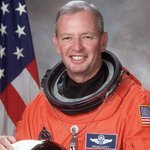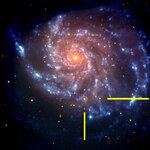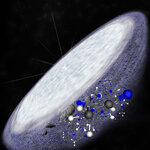Space

A team of astronomers studied the simultaneous collision of four galaxies in the galaxy cluster Abell 3827 and could trace out where the mass lies within the system and compare the distribution of the dark matter with the positions of the luminous galaxies.
Although dark matter cannot be seen, the team could deduce its location using a technique called gravitational lensing. The collision happened to take place directly in front of a much more distant, unrelated source. The mass of dark matter around the colliding galaxies severely distorted spacetime, deviating the path of light rays coming…

It is galaxy season in the northern hemisphere, with Ursa Mayor at the zenith during the night and the Virgo cluster as high as it gets. And if you have ever put your eye on the eyepiece of a large telescope aimed at a far galaxy, you will agree it is quite an experience: you get to see light that traveled for tens or even hundreds of millions of years before reaching your pupil, crossing sizable portions of the universe to make a quite improbable rendez-vous with your photoreceptors. The galaxies at the limit of visibility will channel only a few thousand photons per second inside the…
Titan, Saturn's largest moon, is one of the most Earthlike places in the solar system.
It has a thick, hazy atmosphere and surface rivers, mountains, lakes and dunes, which is why the Cassini-Huygens is studying it. But sometimes new data bring new mysteries, such as the seemingly wind-created sand dunes spotted by Cassini near the moon's equator, and the contrary winds just above.
There's one problem with that. Climate simulations indicate that Titan's near-surface winds -- like Earth's trade winds -- blow toward the west. So why do the surface dunes, reaching a hundred yards…

Space is always on the mind of a veteran NASA astronaut Brian Duffy. The key figure in an aerospace company Orbital ATK and a Space Shuttle commander is extremely keen on flying to space again.
The enthusiasm emanating from him for the future journeys beyond Earth, which we all patiently wait for, is heartily thrilling. In an interview with me, Duffy talks his successful astronaut career, post-NASA endeavors and his love for space.
Did you always know you wanted to be an astronaut?
Brian Duffy: I’ve always been interested in space exploration, be it human or robotic. It captured my…

Not all exoplanets are going to be habitable, many will be just the opposite. Astronomers have measured the temperature of the atmosphere of an exoplanet with unequaled precision and determined we won't be vacationing there any time soon. By crossing two approaches, using the HARPS spectrometer and a new way of interpreting sodium lines, researchers have been able to conclude that exoplanet HD 189733b is showing infernal atmospheric conditions, with wind speeds of more than 1,000 kilometers per hour and a temperature 3,000 degrees.
With a temperature that hot and winds blowing that fast…

How fast the universe has been expanding since the Big Bang is something of a puzzling question. It wasn't that long enough that we didn't know it was accelerating at all, and a new study finds the acceleration of the expansion of the universe might not be as fast as thought.
The currently accepted view of the universe expanding at a faster and faster rate, pulled apart by an unknown force labeled under the umbrella term 'dark energy', is based on observations that resulted in the 2011 Nobel Prize for Physics. But observations based on uniform type Ia supernovae - cosmic "beacons" - may…

Our sun is constantly changing. It goes through cycles of activity - swinging between times of relative calm and times when frequent explosions on its surface can fling light, particles and energy out into space. This activity cycle peaks approximately every 11 years. New research shows evidence of a shorter time cycle as well, with activity waxing and waning over the course of about 330 days.
Understanding when to expect such bursts of solar activity is crucial to successfully forecast the sun's eruptions, which can drive solar storms at Earth. These space weather events can interfere with…

Are the building blocks of life universal?
Astronomers have detected the presence of complex organic molecules, the building blocks of life, in a protoplanetary disc surrounding a young star named MWC 480. That means the conditions that spawned the Earth and Sun are not unique in the Universe.
MWC 480, which is about twice the mass of the Sun, is located 455 light-years away in the Taurus star-forming region. Its surrounding disc is in the very early stages of development — having recently coalesced out of a cold, dark nebula of dust and gas. Studies with ALMA and other telescopes have…

If you are a star gazer, you just got to see a Blood Moon eclipse and if you were thinking that also happened a short while ago, you are not wrong. The latest Blood Moon eclipse is part of a series of four that started on April 14th-15th, 2014 and then again October 7th-8th.
But if you missed this one don't lose hope, another one is coming October 7th-8th. If you see all four, you will witnessed a rare event. Thought tetrads will happen 8 times this century, during a recent 300 year period, the 17th, 18th and 19th centuries, they did not happen at all.
July 6, 1982. ©2003 by Fred Espenak…

Astronomers have determined the pre-explosion mass of a white dwarf star that blew up thousands of years ago and the measurement strongly suggests the explosion involved only a single white dwarf, ruling out a well-established alternative scenario involving a pair of merging white dwarfs.
The researchers analyzed archival observations of a supernova remnant named 3C 397, which is located about 33,000 light-years away in the constellation Aquila. Astronomers estimate this cloud of stellar debris has been expanding for between 1,000 and 2,000 years, making 3C 397 a middle-aged remnant. The team…